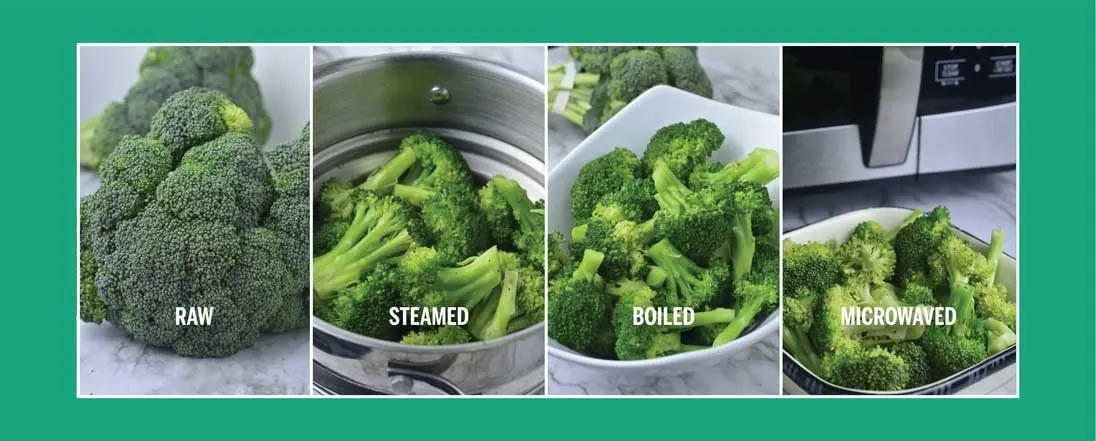
Broccoli is a valuable part of a healthy diet.
Cook it right, and you can turn an ordinary dinner into a flavorful masterpiece. Cook it wrong, and you end up with soggy green mush that tastes about as good as it looks.
How you cook broccoli doesn’t just affect the taste and texture, it also affects the nutritional value too. You could be missing out on the most important nutrients broccoli has to offer because of your cooking technique.
Broccoli is packed with nutritional value that is essential for good health, weight loss, blood sugar control and so much more. Recent science shows that How Broccoli is Cooked spells the difference between it being little more than a high fiber snack, or, a nutrient-rich superhero food. Which one do you want on your plate?
What Are The Nutrients in Broccoli?
Broccoli is a nutrient-dense, dark green vegetable from the Cruciferous family (which includes Bok Choy, Kale, Mustard greens, and more).
According to the USDA, broccoli is rich in Vitamins A, C, B6, and the blood clotting factor vitamin K. It is a good source of the minerals magnesium, potassium, calcium and iron, and it contains dietary fiber which is critical to maintaining a healthy gut.

But broccoli is also rich in the plant chemicals known as flavonoids.
Depending on how you cook broccoli, you may be losing these super-hero chemicals that actually help your body to fight disease. Let’s dive in a little deeper to see why choosing the right cooking method is so important.
What Are Flavonoids?
Flavonoids are chemicals found in plants that contribute to the color, smell and taste of different vegetables and fruits. There are more than 6,000 types of these plant-based nutrients (also called phytonutrients) found in vegetables.
The flavonoids that are found in broccoli include a class called glucosinolates (1). These flavonoids give broccoli its strong smell and are part of the plant’s defense mechanism against insects and diseases.
These same glucosinolates have been shown to have anti-inflammatory, antioxidant and immune boosting properties in humans (2). Research has linked the regular consumption of broccoli with reductions in inflammation, heart disease, cancer and diabetes (2). Specific research is looking at the role of broccoli flavonoids in preventing and treating cancers that include prostate cancer, colorectal cancer, lung cancer and breast cancer (3).
So if you want to maximize the health benefits of eating broccoli, then you need to focus on preparing it in a way that maximizes the flavonoid content.
Raw is Not Always the Best Option
Although science has long determined that cooking affects the nutritional value of foods in different ways, many people assume that eating raw vegetables like broccoli is the healthiest choice.
It can be very difficult to compare the nutritional value of raw vs cooked foods (4) because there are so many factors that influence the result of cooking. Everything from the way the vegetable is stored and prepared to the length of cooking time and the type of cooking pot can affect the outcome of a nutritional analysis.
A 2019 USDA study set out to determine the best way to prepare broccoli at home to retain the most cancer-fighting flavonoids like the glycosides. Home preparation is key because many nutritional studies are done in laboratories with methods that cannot be replicated at home. That means your results cannot compare to the lab results. But by using home-cooking methods, this study provides a better indication of how to retain flavonoids, especially the cancer-fighting glycosides, in your own diet.
The study compared the flavonoid content of raw broccoli with the results after cooking using 3 common methods:
- Boiling
- Steaming
- Microwaving

How to Cook Broccoli and Retain Flavonoids
Raw broccoli is the starting point for this comparison. All of the glycoside flavonoids in raw broccoli represent a value of 100% flavonoid retention. Since the broccoli isn’t being heated or treated in any way, it has all of its phytochemicals intact.
The point of this study was not to compare the effects of different cooking times or temperatures but to focus on the outcome of flavonoid retention for common household broccoli recipes.
Of the three cooking methods tested, boiling in water resulted in the largest loss of flavonoids from the broccoli. More than half of the glycoside flavonoids are lost during boiling, even when the time was limited to only 85 seconds. Boiling leaches the nutrients out.
Microwaving turns out to be the best way to cook broccoli. The results show that flavonoids actually increase to levels beyond those apparently present in raw broccoli following a short period of microwaving with minimal water.

How can microwaving increase the flavonoid content over the amount present in raw broccoli?
It is likely that the temperature and softening of the broccoli tissues that occur during microwaving cause the flavonoids to be easier to extract. In other words, microwaving makes broccoli flavonoids more bioavailable. It is better to eat broccoli microwaved than raw
Key Takeaways From The Study:
- Boiling led to considerable loss of flavonoids (Greater than 50% loss)
- Only minor loss was observed in steamed broccoli. ( ~ 20% loss)
- Apparent gain was observed in microwaved broccoli. (~ 28% gain)
- Of the three cooking methods, microwaving appeared to be the best method to retain complex flavonoids in broccoli, followed by steaming.
Limitations of the Study
It is important to note that the results of this study cannot be easily extrapolated to other vegetables, even ones that contain similar compounds. Flavonoid retention is affected by the specific compounds found in the vegetable, the food matrix, cooking method, and handling of the vegetable.
Fair Use Statement
Feel free to share any of the images and recipes found on this page, however, we request that you link to this page and attribute cheflolaskitchen.com so that your users may have access to all the assets and information available.
